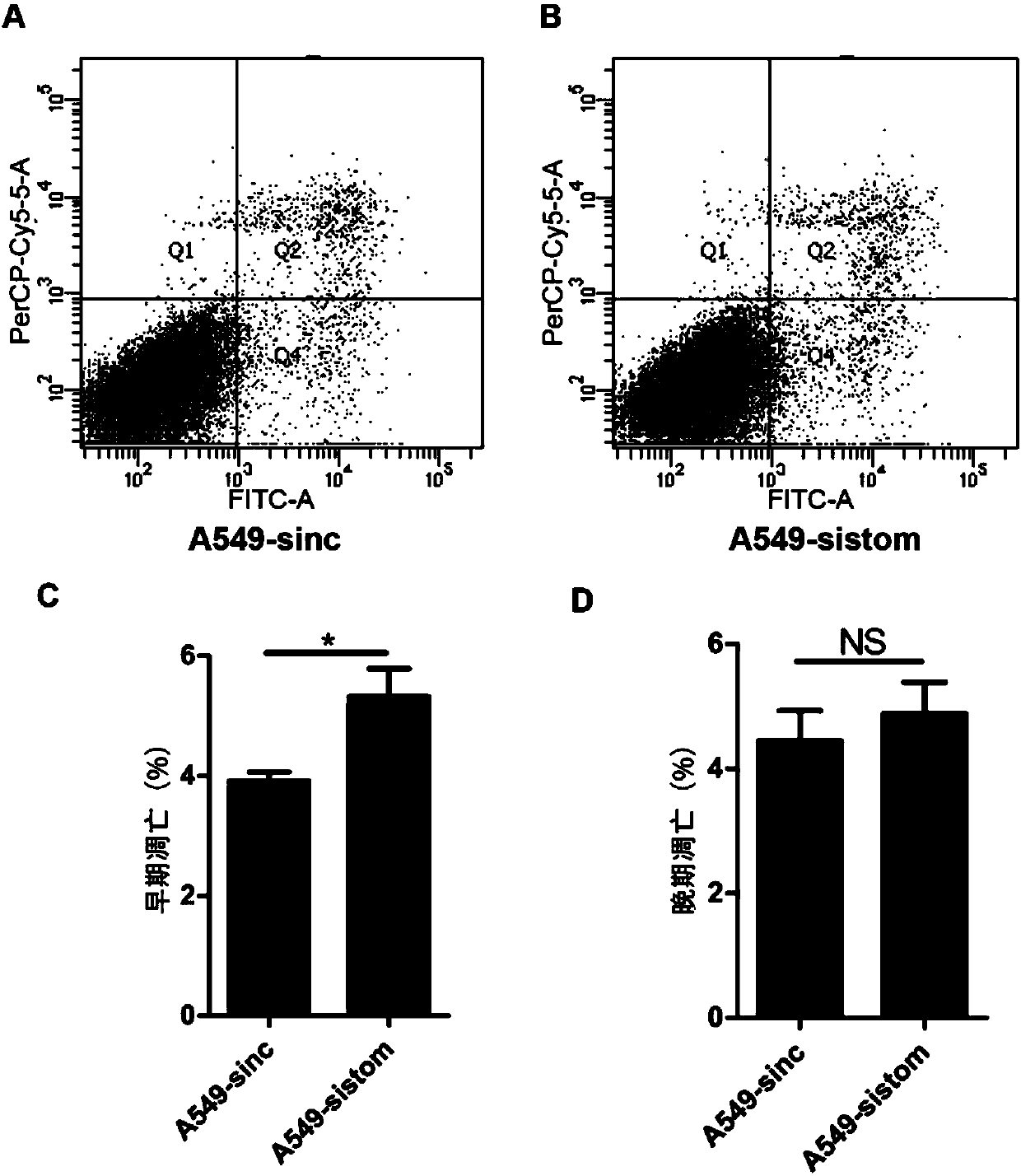Application of stomatin protein and its coding gene in diagnosis and treatment of lung cancer
A gene and protein technology is applied in the application field of stomatin protein and its encoding gene in the diagnosis and treatment of lung cancer, which can solve the problems of unclear function and function of stomatin.
- Summary
- Abstract
- Description
- Claims
- Application Information
AI Technical Summary
Problems solved by technology
Method used
Image
Examples
Embodiment 1
[0090] Embodiment 1, cell preparation
[0091] 1. Cell preparation for transient knockdown of stomatin expression
[0092] 1. Design siRNA for the stomatin gene, the sequence is as follows:
[0093] Sense strand (5'-3'): GGAAUGUUCUGGGCACCAA dTdT;
[0094] Antisense strand (3'-5'): dTdT CCUUACAAGACCCGUGGUU.
[0095] 2. Artificially synthesize the siRNA in step 1.
[0096] 3. Take the siRNA synthesized in step 2, and use the small RNA transfection kit (Ribobio, Cat. No.: C10511-1) to transfect A549 cells (refer to the kit manual for the method), and set up the cells in the experimental group transfected with siRNA and those without transfection. The cells of the control group transfected with siRNA were harvested after 48 hours for detection or follow-up experiments.
[0097] 4. Take the siRNA synthesized in step 2, and use the small RNA transfection kit to transfect H520 cells (refer to the kit manual for the method), set up the experimental group cells transfected with siR...
Embodiment 2
[0118] Embodiment 2, the effect of stomatin on tumor cell proliferation
[0119] 1. MTT experiment
[0120] The proliferation of A549-sinc, A549-sistom, H520-sinc and H520-sistom was detected by MTT method.
[0121] Seed cells in a 96-well plate, 1000-5000 cells per well (set up 5 experimental wells for each cell and 1 well for blank control wells without inoculating cells), start detection on the first day after the cells adhere to the wall, and detect for 5 days in total , the detection method is as follows:
[0122] (1) Take a 96-well plate, discard the supernatant, and add 100 μl of MTT solution to each well;
[0123] (2) Place in the incubator, and develop color for 4 hours;
[0124] (3) Discard the supernatant, add 150 μl DMSO to each well, and shake for 10 minutes to dissolve the crystals;
[0125] (4) 490nm wavelength, detect the OD value of each well (the OD value of the experimental well - the OD value of the blank control well).
[0126] The result is as figure ...
Embodiment 3
[0136] Embodiment 3, the impact of stomatin on tumor cell metastasis and spread
[0137] one,
[0138] A 24-well plate scratch experiment was performed on A549-sistom cells and A549-sinc cells.
[0139] Take a 24-well plate full of cells, first draw three horizontal lines with a marker on the bottom of the well plate; draw three vertical lines with a pipette tip vertically and not tilted; wash three times with PBS, add serum-free medium, and culture at 37°C, respectively. Take more than 5 identical fields of view at 0h and 24h.
[0140] After 24 hours, the scratches healed as Figure 6 As shown in A (the field of view magnification is 100 times), calculate the migration distance of moving cells in 8 randomly selected fields of view, and the results are as follows Figure 6 Shown in B.
[0141] two,
[0142] Cell migration experiments were performed on A549-shstom cells and A549-shnc cells.
[0143] (1) Before preparing the cell suspension, starve the cells for 12-24 hour...
PUM
 Login to View More
Login to View More Abstract
Description
Claims
Application Information
 Login to View More
Login to View More - R&D
- Intellectual Property
- Life Sciences
- Materials
- Tech Scout
- Unparalleled Data Quality
- Higher Quality Content
- 60% Fewer Hallucinations
Browse by: Latest US Patents, China's latest patents, Technical Efficacy Thesaurus, Application Domain, Technology Topic, Popular Technical Reports.
© 2025 PatSnap. All rights reserved.Legal|Privacy policy|Modern Slavery Act Transparency Statement|Sitemap|About US| Contact US: help@patsnap.com



